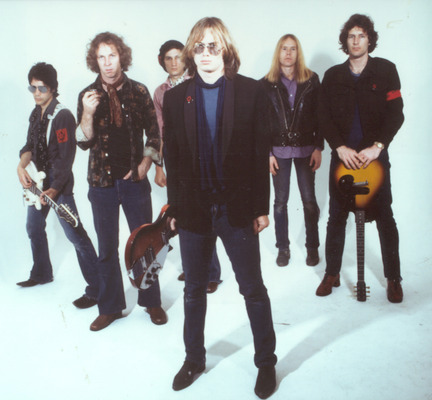Magic In The Maelstrom
A new documentary sheds new light on legendary Australian proto-punkers Radio Birdman

Not unlike the slow-burn way the legend of Radio Birdman made it’s way through the American underground punk scene through the 1980s, this excellent documentary about the band has been winding around for a little bit too. It came out in 2017; has been on DVD for a little bit; and a friend of mine just watched it on the Night Flight app recently. But like the intrinsic joy of the live band experience always being more impactful than watching a “live” YouTube clip, seeing Descent Into the Maelstrom on a big screen with loud sound is the way to see it, if you can. This Brooklyn stop was the second-to-last on a six-city screening tour.
As far as punk rock documentaries, maybe nothing will ever beat the emotional and historical depths of The Ramones: End of the Century; or the heated, revolutionary impact of the sadly stuck in litigation MC5 film, A True Testimonial. But this history of the Australian punk rock originators shoves in tons of its own emotional wallops and more than enough searing live footage and crazed story-telling to not only satisfy fans, but make a case to a larger rock audience. Especially for America.
For whatever myriad reasons (mostly the far away location and inability for Aussie bands to tour much), the mid-70s Aussie punk scene still gets short shrift around here. This film reminds us that Radio Birdman began in 1974, pre-dating the majority of bands you’d see in any of the many generic “punk documentaries.” But as the film points out, the band never felt a part of that genre anyway when it was quickly codified in the latter ’70s. (They seemed to have felt apart from everything.) The band organically grew out of a love of the quite busy late-60s Aussie garage rock scene, plus a quick, subsequent dissatisfaction with where rock was going by the early ’70s, which is to say nowhere, especially Down Under.
In the after-screening Q&A with director Jonathan J. Sequeira and founder and guitarist Deniz Tek, Tek explained how basically the scene around Sydney radio and bars was neutered boogie rock and “some like Celtic folk stuff.” The film does a great job convincing you that Radio Birdman really did rise from nowhere, or at least a nowhere that included a couple failed teen bands. (And in this obviously well-researched and archived film, they even found some pictures and sounds from those teen bands, and damn, I sure hope someone can release that stuff eventually!)
Tek was born in Ann Arbor, Michigan, and brought his pre-teen love of that infamous late-60s/early-70s scene and sound with him when he moved to Australia in 1972. But he soon met other local outcasts who had a clue about the proto-punk bands of the era. But the sheer speed and lacerating intensity of Birdman’s guitar slashing and singer Rob Younger’s anti-authoritarian bent became its own sound soon enough. While their equally influential brethren band, The Saints, get a quick mention in this film, the two bands have long-since become top-tiered punk rock influences, and honored legends in their home country.

After finding their footing sonically, Radio Birdman became the center of a wild vortex going on at the Funhouse, a Sydney club that housed the quickly burgeoning punk scene around 1977-78. And soon, the band and their management saw them as truly revolutionary, the Aussie exemplar of similar DIY scenes that were popping up around the world. And the band took on a kind of guitar army image and stance, with fans donning their jackets, and sometimes their skin, with the Birdman logo, and chanting the fist-pumped allegiance of “Yeah Hup!” Insinuations of a fascist bent were met by the band with shock and implorations that they were all just having fun. Tek and the band manager though genuinely seemed to be excited about the way they dragged the moribund Sydney, and ultimately Australian scene from the depths of drab, corduroy, 1970s AOR. It was all basically a more searingly intense version of the classic youthful desire to find your scene and dive in full force.
As Sequeira explained in the Q&A, bassist Warwick Gilbert had been making these animated storyboards of some of the legendary Funhouse stories, for a cartoon movie idea. (Gilbert eventually became a very successful animator.) Sequeira loved them and asked if he could use a few in the film. They make for a great way to show stories that obviously were not captured in pre-cell phone times, and work to give the film some moments of fun, nostalgic levity to balance the intense personal animosities that creep in as the film unspools.
The intense part, the film implies, came primarily from Tek and singer Rob Younger, who took the band extremely seriously. The band’s kind of parodic militant stance (Tek himself was in the air force at one time) is well-mirrored by the documentary’s structure. It follows a fairly standard, if justifiably fast, chronological documentary style, but cuts in with jumps back to members’ upbringings, amazingly restored found live footage, and cool, slashy graphics. One fun tact was placing a flag with the Birdman logo behind each member in the current-day interviews, even members who admitted that they want nothing to do with the band anymore. It’s a sly acknowledgement that your past, and a band as amazingly powerful as Radio Birdman, will always follow you.
Tek and keyboardist Pip Hoyle met at medical school, and were both attempting to keep those careers going while their band went about playing pubs to drunk teens and angry bikers, while slowly spreading their rep and getting attention from major labels around the world. And the implication is that the members’ divergent life goals were exposed at exactly the same time they were about to perhaps blow up. A deal with Sire Records in America meant a planned, nationwide tour opening for the Ramones, but the band was dropped before that happened. (They never did properly tour the States until 2006; and have been back a few times with various lineups.) Tek mentioned in the Q&A that the Euro pressings of the Sire version of their debut indie album were left in boxes, unsold or sent to cutout bins all over the world — only to be snatched up by proto-punk fans for the next 10 years, as Radio Birdman’s legend grew.

Talking with a friend after the screening, we discussed the various and sometimes confusing ways that films are distributed today, and the lessened initial impact a film can make anymore, compared to the days of a concerted big release push. It’s interesting to dote on, but doesn’t really matter — well, maybe to those who sunk money into making the film. As a fan, when you see the amazing, rare live clips in the film, you wish they could add those whole shows to the DVD extras, until you hear that one of the Aussie networks who owned and provided some of the clips asks for $1,000 per minute for use!
But anyway, what matters–especially when it comes to entities that were doomed to never get that big concerted push in the first place–is if and hopefully when you finally find the film. Hell, it’s 2018. Try to book it yourself! Yeah hup!!
This is a link to where you can screen the film!




